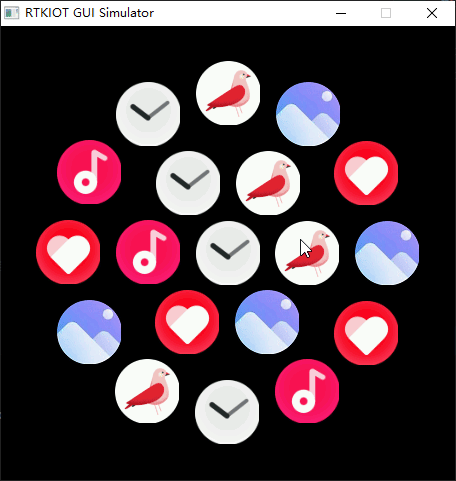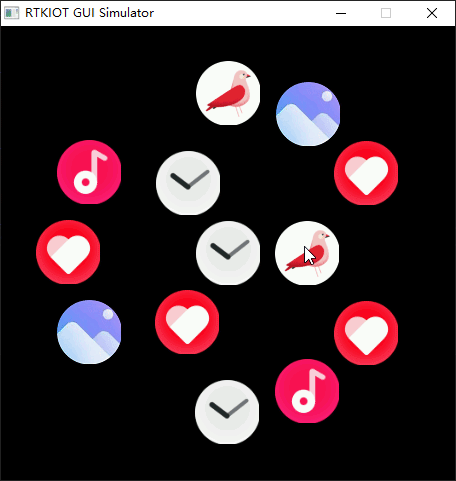Wheel list
The wheellist widget is an application list interface, mainly composed of application icons arranged in multiple circular layers. Each layer can rotate independently, and each icon can have an associated callback.
Usage
Create a wheel list
gui_wheel_list_t *gui_wheel_list_create(void *parent, uint8_t layer, uint8_t radius, uint8_t distence) creates a wheel list widget.
layer is the number of layers of the round wheel, 1 means there is one circle of outer icons in addition to the center icon.
radius is the radius of the icon. If the icon is square, it is half of the side length of the icon image. This value needs to be accurate, otherwise errors will occur in the icon arrangement calculation and position calculation.
distance is the distance between the centers of the icons of two adjacent layers, which needs to be greater than the diameter or side length of the icon.
In Layer 0, there is a central icon, whose center is at the center of the screen. This point serves as the reference for calculating the positions of other icons. The number of icons in each layer is 6*n, where n represents the number of icon layers. Therefore, the closer to the outer layer, the more icons there are, and the smaller the angle between the centers of adjacent icons and the center of the screen on the same layer.
Add icon
Default
After creating the wheel list widget, you can use the default interface for adding icons. In the wheel, corresponding icons can be added from the inside out in a layer-by-layer fashion. void gui_wheel_list_add_icon_default(gui_wheel_list_t *this, void *icon_addr,gui_event_cb_t event_cb)
this is the pointer to the widget.
icon_addr is the pointer to the address of the image.
event_cb is the callback function of this image, triggered by clicking.
Default example
Example code
#include "gui_wheel_list.h"
#include "gui_img.h"
#include "gui_app.h"
#include "root_image_8762g/ui_resource.h"
static void app_launcher_ui_design(gui_app_t *app);
static gui_app_t app_launcher =
{
.screen =
{
.name = "app_launcher",
.x = 0,
.y = 0,
},
.ui_design = app_launcher_ui_design,
.active_ms = 1000 * 5,
};
gui_app_t *get_launcher_app(void)
{
return &app_launcher;
}
static void app_wheel_ui_design(gui_app_t *app);
static gui_app_t app_wheel =
{
.screen =
{
.name = "app_wheel",
.x = 0,
.y = 0,
},
.ui_design = app_wheel_ui_design,
.active_ms = 1000 * 5,
};
gui_app_t *get_wheel_app(void)
{
return &app_wheel;
}
static void wheel_cb(void *obj, gui_event_t event)
{
}
static void switch_to_launcher(void *obj, gui_event_t event)
{
gui_switch_app(get_wheel_app(), get_launcher_app());
}
static void app_wheel_ui_design(gui_app_t *app)
{
gui_wheel_list_t *hc = gui_wheel_list_create(&app->screen, 2, 32, 80);
gui_wheel_list_add_icon_default(hc, ICMENUALARM_BIN, switch_to_launcher);
gui_wheel_list_add_icon_default(hc, ICMENUBIRD_BIN, wheel_cb);
gui_wheel_list_add_icon_default(hc, ICMENUALBUM_BIN, wheel_cb);
gui_wheel_list_add_icon_default(hc, ICMENUHEARTRATE_BIN, wheel_cb);
gui_wheel_list_add_icon_default(hc, ICMENUMUSIC_BIN, wheel_cb);
gui_wheel_list_add_icon_default(hc, ICMENUALARM_BIN, wheel_cb);
gui_wheel_list_add_icon_default(hc, ICMENUBIRD_BIN, wheel_cb);
gui_wheel_list_add_icon_default(hc, ICMENUALBUM_BIN, NULL);
gui_wheel_list_add_icon_default(hc, ICMENUHEARTRATE_BIN, NULL);
gui_wheel_list_add_icon_default(hc, ICMENUMUSIC_BIN, NULL);
gui_wheel_list_add_icon_default(hc, ICMENUALARM_BIN, NULL);
gui_wheel_list_add_icon_default(hc, ICMENUBIRD_BIN, NULL);
gui_wheel_list_add_icon_default(hc, ICMENUALBUM_BIN, NULL);
gui_wheel_list_add_icon_default(hc, ICMENUHEARTRATE_BIN, NULL);
gui_wheel_list_add_icon_default(hc, ICMENUMUSIC_BIN, NULL);
gui_wheel_list_add_icon_default(hc, ICMENUALARM_BIN, NULL);
gui_wheel_list_add_icon_default(hc, ICMENUBIRD_BIN, NULL);
gui_wheel_list_add_icon_default(hc, ICMENUALBUM_BIN, NULL);
gui_wheel_list_add_icon_default(hc, ICMENUHEARTRATE_BIN, NULL);
}
static void app_launcher_ui_design(gui_app_t *app)
{
}

Customized
After creating the wheel list widget, you can use the default interface for adding icons. In the wheel, corresponding icons can be added from the inside out in a layer-by-layer fashion. gui_wheel_list_set_icon(gui_wheel_list_t *this, void *icon_addr, gui_event_cb_t event_cb, uint8_t layer, uint8_t index)
this is the pointer to the widget.
icon_addr is the pointer to the address of the image.
event_cb is the callback function of this image, triggered by clicking.
layer is the level or layer where the icon is located.
Customized example
Example code
#include "gui_wheel_list.h"
#include "gui_img.h"
#include "gui_app.h"
#include "root_image_8762g/ui_resource.h"
static void app_launcher_ui_design(gui_app_t *app);
static gui_app_t app_launcher =
{
.screen =
{
.name = "app_launcher",
.x = 0,
.y = 0,
},
.ui_design = app_launcher_ui_design,
.active_ms = 1000 * 5,
};
gui_app_t *get_launcher_app(void)
{
return &app_launcher;
}
static void app_wheel_ui_design(gui_app_t *app);
static gui_app_t app_wheel =
{
.screen =
{
.name = "app_wheel",
.x = 0,
.y = 0,
},
.ui_design = app_wheel_ui_design,
.active_ms = 1000 * 5,
};
gui_app_t *get_wheel_app(void)
{
return &app_wheel;
}
static void wheel_cb(void *obj, gui_event_t event)
{
}
static void switch_to_launcher(void *obj, gui_event_t event)
{
gui_switch_app(get_wheel_app(), get_launcher_app());
}
static void app_wheel_ui_design(gui_app_t *app)
{
gui_wheel_list_t *hc = gui_wheel_list_create(&app->screen, 2, 32, 80);
gui_wheel_list_set_icon(hc, ICMENUALARM_BIN, switch_to_launcher, 0, 0);
gui_wheel_list_set_icon(hc, ICMENUBIRD_BIN, wheel_cb, 1, 0);
gui_wheel_list_set_icon(hc, ICMENUHEARTRATE_BIN, wheel_cb, 1, 2);
gui_wheel_list_set_icon(hc, ICMENUALARM_BIN, wheel_cb, 1, 4);
gui_wheel_list_set_icon(hc, ICMENUHEARTRATE_BIN, NULL, 2, 1);
gui_wheel_list_set_icon(hc, ICMENUMUSIC_BIN, NULL, 2, 2);
gui_wheel_list_set_icon(hc, ICMENUALARM_BIN, NULL, 2, 3);
gui_wheel_list_set_icon(hc, ICMENUALBUM_BIN, NULL, 2, 5);
gui_wheel_list_set_icon(hc, ICMENUHEARTRATE_BIN, NULL, 2, 6);
gui_wheel_list_set_icon(hc, ICMENUMUSIC_BIN, NULL, 2, 7);
gui_wheel_list_set_icon(hc, ICMENUBIRD_BIN, NULL, 2, 9);
gui_wheel_list_set_icon(hc, ICMENUALBUM_BIN, NULL, 2, 10);
gui_wheel_list_set_icon(hc, ICMENUHEARTRATE_BIN, NULL, 2, 11);
}
static void app_launcher_ui_design(gui_app_t *app)
{
}

API
Defines
-
RADIAN_60
Enums
Functions
-
gui_wheel_list_t *gui_wheel_list_create(void *parent, uint8_t layer, uint8_t radius, uint8_t distence)
Create a scroll wheel icon list widget.
- Parameters:
parent – the father widget the page nested in.
layer – the layer of the wheel list, 0 means there is only one icon in the middle.
radius – Icon image radius.
distence – Distance between the shortest circle center of two layer icon images.
- Returns:
gui_wheel_list_t*
-
void gui_wheel_list_add_icon_default(gui_wheel_list_t *this, void *icon_addr, gui_event_cb_t event_cb)
Add icon images in the default order.
- Parameters:
this – widget object pointer
event_cb – click cb of this image
icon_addr – picture address
-
void gui_wheel_list_set_icon(gui_wheel_list_t *this, void *icon_addr, gui_event_cb_t event_cb, uint8_t layer, uint8_t index)
Add icon images.
- Parameters:
this – widget object pointer
icon_addr – picture address
event_cb – click cb of this image
layer – layer
index – index
-
struct WHEEL_ANGLE_T
- #include <gui_wheel_list.h>
-
struct gui_wheel_list_t
- #include <gui_wheel_list.h>